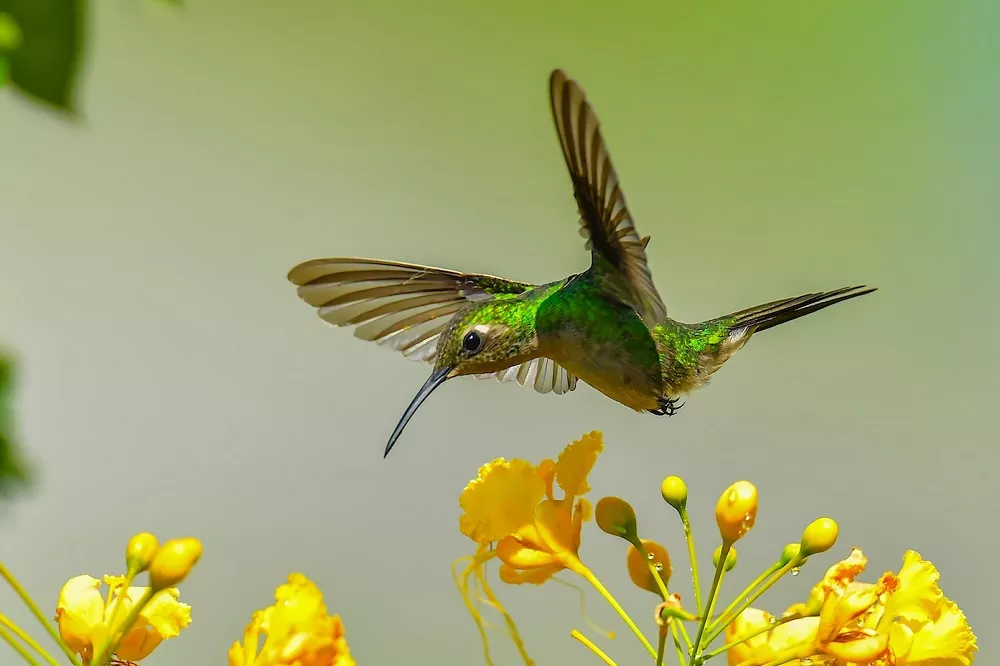The Bee Hummingbird, also known as the Helena Hummingbird or the Zunzuncito (scientific name: Mellisuga helenae), is the smallest bird species in the world. It is native to Cuba and is found in the eastern and central regions of the country.
Adult Bee Hummingbirds typically measure about 2.25 inches (5.7 centimeters) in length and weigh only about 0.07 ounces (2 grams). They have a vibrant plumage with iridescent feathers that can appear green, blue, or reddish-brown depending on the angle of light. Males have more colorful feathers, including a bright iridescent red throat patch, called a gorget, which they display during courtship to attract females.
Physical Characteristics
Despite its diminutive size, the bee hummingbird is a vibrant and eye-catching bird. Males have iridescent feathers that range in color from green to blue, while females have more subdued feathers that are a mix of gray and white. Both sexes have a distinctive reddish-pink beak and feet.
One of the most remarkable features of the bee hummingbird is its ability to hover in place while feeding. It beats its wings at an incredible rate of up to 80 times per second, allowing it to maintain a stationary position as it sips nectar from flowers.
Habitat and Range
As previously mentioned, the bee hummingbird is found only in Cuba. It is primarily found in the eastern and central parts of the island, where it inhabits forests, woodlands, and gardens. Due to habitat loss and fragmentation, however, the bee hummingbird’s numbers have declined in recent years, and it is now considered a threatened species.
Diet and Behavior
Like all hummingbirds, the bee hummingbird feeds primarily on nectar from flowers. It also eats small insects and spiders for protein. Due to its small size, the bee hummingbird must feed frequently to maintain its high metabolism.
In addition to their impressive hovering abilities, bee hummingbirds are known for their acrobatic flight patterns. They can fly forwards, backwards, and even upside down, making them a joy to watch for birdwatchers and researchers alike.
Breeding and Reproduction
The breeding habits of the bee hummingbird are not well-documented, due in large part to their small size and elusive nature. It is believed that males perform elaborate courtship displays in order to attract females, but little is known about the specifics of these displays.
Females typically lay one or two eggs at a time, which they incubate for 14-19 days. Both parents share in the feeding and care of the hatchlings, which fledge after about three weeks.
Conservation Status
As previously mentioned, the bee hummingbird’s numbers have declined in recent years due to habitat loss and fragmentation. It is now considered a threatened species by the International Union for Conservation of Nature (IUCN).
Efforts are underway to conserve the bee hummingbird and its habitat. One such effort is the creation of protected areas in Cuba that will provide a safe haven for the bird and other threatened species. The Cuban government has also implemented regulations to limit the capture and trade of the bee hummingbird, which has historically been a threat to its survival.
Conclusion
The bee hummingbird may be tiny, but it is a fascinating and important species that deserves our attention and protection. As with all threatened species, it is up to us to take action to ensure that this incredible bird continues to thrive for generations to come. By supporting conservation efforts and spreading awareness about the bee hummingbird and its unique characteristics, we can all play a role in ensuring the survival of this remarkable species.
Related topics:
- World’s Smallest Hummingbird – The Bee Hummingbird
- What does a Bee Hummingbird eat?
- How To Attract Hummingbirds, 5 Effective Methods
- How long do Hummingbirds live?
- How to make sugar water for Hummingbirds (A Full Guide)


 Facebook
Facebook  Instagram
Instagram  Youtube
Youtube 